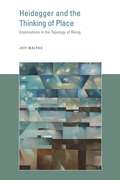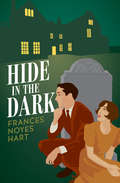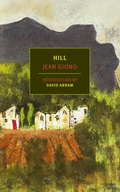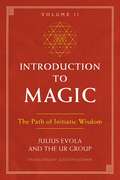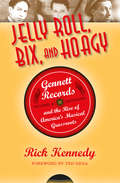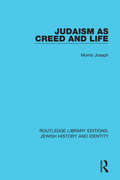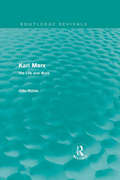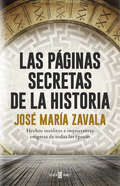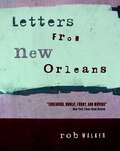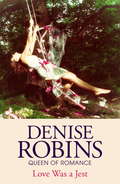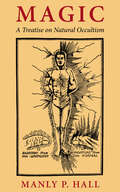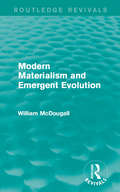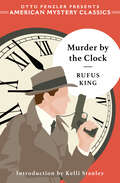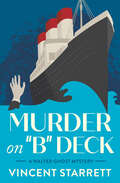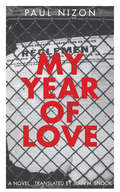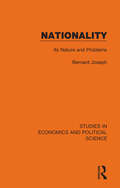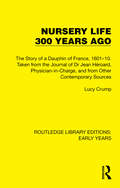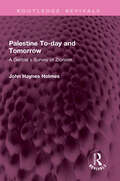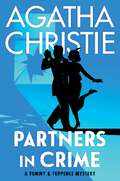- Table View
- List View
Heidegger and the Thinking of Place
by Jeff MalpasThe idea of place--topos--runs through Martin Heidegger's thinking almost from the very start. It can be seen not only in his attachment to the famous hut in Todtnauberg but in his constant deployment of topological terms and images and in the situated, "placed" character of his thought and of its major themes and motifs. Heidegger's work, argues Jeff Malpas, exemplifies the practice of "philosophical topology. " In Heidegger and the Thinking of Place, Malpas examines the topological aspects of Heidegger's thought and offers a broader elaboration of the philosophical significance of place. Doing so, he provides a distinct and productive approach to Heidegger as well as a new reading of other key figures--notably Kant, Aristotle, Gadamer, and Davidson, but also Benjamin, Arendt, and Camus. Malpas, expanding arguments he made in his earlier book Heidegger's Topology (MIT Press, 2007), discusses such topics as the role of place in philosophical thinking, the topological character of the transcendental, the convergence of Heideggerian topology with Davidsonian triangulation, the necessity of mortality in the possibility of human life, the role of materiality in the working of art, the significance of nostalgia, and the nature of philosophy as beginning in wonder. Philosophy, Malpas argues, begins in wonder and begins in place and the experience of place. The place of wonder, of philosophy, of questioning, he writes, is the very topos of thinking.
Hide in the Dark
by Frances Noyes HartAt a manor in Maryland, thirteen guests gather to celebrate Halloween—but before the party is over, only twelve are left alive . . . Halloween night, 1928. It has been years since a group of friends, all of them witty, well-dressed, and wealthy, have gathered at the house known as Lady Court—and since one of their own died tragically young. But despite the haunting memory of poor Sylvia and the secrets still lurking among them, the old friends&’ appear to be in high spirits. Amid the laughter, they play holiday-themed games, one of which requires the lights to be turned off. It is during this brief darkness that one of their party is murdered.Now, as a storm rages and knocks the telephone line out, the atmosphere of fun and flirtation turns to fear, and the rest of the night will be spent trying to unmask a killer . . . &“Hart . . . has inlaid her mystery with a filigree of wit and romance.&” —Time
Hill
by David Abram Jean Giono Paul EprileAn NYRB Classics Original Deep in Provence, a century ago, four stone houses perch on a hillside. Wildness presses in from all sides. Beyond a patchwork of fields, a mass of green threatens to overwhelm the village. The animal world--a miming cat, a malevolent boar--displays a mind of its own. The four houses have a dozen residents--and then there is Gagou, a mute drifter. Janet, the eldest of the men, is bedridden; he feels snakes writhing in his fingers and speaks in tongues. Even so, all is well until the village fountain suddenly stops running. From this point on, humans and the natural world are locked in a life-and-death struggle. All the elements--fire, water, earth, and air--come into play. From an early age, Jean Giono roamed the hills of his native Provence. He absorbed oral traditions and, at the same time, devoured the Greek and Roman classics. Hill, his first novel and the first winner of the Prix Brentano, comes fully back to life in Paul Eprile's poetic translation.
In the Wilderness: The Master of Hestviken, Vol. 3 (Master of Hestviken #3)
by Sigrid UndsetIt is Norway in the thirteenth century, a land rent by unremitting warfare and feebly lit by Christianity. Olav Audunsson was once an outlaw; now he is a man of wealth and stature. But he is haunted by the memory of crimes for which there is no easy atonement and by losses that may never be redeemed.
Intelligence power in peace and war
by Michael HermanIntelligence services form an important but controversial part of the modern state. Drawing mainly on British and American examples, this book provides an analytic framework for understanding the "intelligence community" and assessing its value. Michael Herman, a former senior British Intelligence officer, describes the various components of intelligence; discusses what intelligence is for; considers issues of accuracy, evaluation and efficiency; and makes recommendations for the future of intelligence in the post-Cold War world.
International Language
by Otto JespersenThis book was first published in 1929, International Language is a valuable contribution to the field of English Language and Linguistics.
Introduction to Magic, Volume II: The Path of Initiatic Wisdom
by Julius Evola The UR GroupAuthentic initiatic practices, rituals, and wisdom collected by the UR Group • Shares a rigorous selection of initiatory exercises, including instructions for creating the diaphanous body of the Opus magicum, establishing initiatic consciousness after death, and the construction of magical chains (the enchained awareness of initiates) • Offers studies of mystery traditions throughout history, presenting not only the principles themselves but also witnesses to them and their continual validity today The “Gruppo di UR” was a group of Italian esotericists who collaborated from 1927 to 1929. The purpose of this group was to study and practice ancient rituals gleaned from the mystery traditions of the world, both East and West, in order to attain a state of superhuman consciousness and power to allow them to act magically on the world. They produced a monthly journal containing techniques for spiritual realization, accounts of personal experiences, translations of ancient texts, and original essays on esoteric topics. The group included a distinguished line-up of occultists, neo-pagans, freemasons, Anthroposophists, orientalists, poets, and members of high society. The prime movers of the group were Arturo Reghini (1878-1946), a Pythagorean mathematician and reviver of a spiritual Freemasonry, and Julius Evola (1898-1974), then a young philosopher with a precocious mastery of the esoteric doctrines of East and West. Many years later, in 1971, Evola gathered these essays into three volumes. Inner Traditions published Volume I in 2001, under the title Introduction to Magic: Rituals and Practical Techniques for the Magus. This volume, the second in the series, complements the first one, yet they are not strictly sequential, and their contents can be read in any order. Volume II shares authentic initiatic wisdom and a rigorous selection of initiatory exercises, including instructions for creating the diaphanous body of the Opus magicum, establishing initiatic consciousness after death, and the construction of magical chains (the enchained awareness of initiates). It offers studies of mystery traditions throughout history, presenting not only the principles themselves but also witnesses to them and their continual validity today. This series shows that the “Magic” of the UR Group meant an active and affirmative attitude toward individual development, handed down from a “primordial tradition” and discernable in alchemy, Hermetism, esoteric religious doctrines, indigenous practices, Tantra, Taoism, Buddhism, Vedanta, and the pagan mysteries of the West. Although some of the practical experiments demanded extraordinary efforts, both individual and collective, there is incalculable value here even for the less heroic, for merely reading these essays leaves a permanent mark on the reader.
Jelly Roll, Bix, and Hoagy: Gennett Records and the Rise of America's Musical Grassroots
by Rick Kennedy&“A lively and anecdotal history&” of the tiny family-run studio where jazz greats from Jelly Roll Morton to Louis Armstrong made their first recordings (Jazz Times). From 1917 to 1932, in a primitive studio next to the railroad tracks, the Gennett family of Richmond, Indiana, recorded some of the earliest performances of jazz, blues, and country greats—including Jelly Roll Morton, Big Bill Broonzy, King Oliver, Louis Armstrong, Gene Autry, Bix Beiderbecke, and native Hoosier Hoagy Carmichael (whose &“Stardust&” debuted on Gennett as a dance stomp). Jelly Roll, Bix, and Hoagy is the first thoroughly researched account of the people and events behind this unique company and its outsized impact on American music. Alive with personal details and anecdotes from musicians, employees, and family members, it traces the colorful history of a pioneer recording company.
Judaism as Creed and Life (Routledge Library Editions: Jewish History and Identity)
by Morris JosephOriginally published in its sixth edition in 1929, this volume was one of the first to have appeared in England which was written from a liberal standpoint. It gives a comprehensive account of Jewish belief and practice as conceived by those of moderate views. A significant part of the book covers Jewish ethics, and specifically their practical aspects as well as advice for Jewish teenagers of Confirmation age.
Karl Marx: His Life and Work (Routledge Revivals)
by Otto RühleFirst published in English in 1929, this is a reissue of Otto Rühle's comprehensive biography of Karl Marx. Written by a leading Marxist and key figure within the German Labour movement, this is an exceptionally detailed and well-researched study which sets Marx's life and work firmly within its social and historical context before examining in depth the major events of his life and the writings for which he has become such an influential figure in modern political philosophy. The final chapter offers an appraisal of both the man and his work, as Rühle summarises why he believes Marx was a genius.
Las páginas secretas de la historia: Hechos insólitos e inquietantes enigmas de todas las épocas
by José María Zavala¿Estuvo Agatha Christie enamorada de Alfonso XIII? ¿Hizo el violinista Paganini un pacto con el diablo? ¿Qué gran misterio descubrió Albert Einstein que todavía ignorábamos? Las páginas secretas de la historia es un apasionante recorrido a través de hechos históricos insólitos, misterios, datos increíbles e inquietantes enigmas. El historiador es un profeta del pasado. José María Zavala vuelve a enfundarse su gabardina detectivesca y toma los mandos de su nave para invitarnos a viajar con él a través de los túneles inexplorados de la Historia. Descubriremos así quién fue en realidad Sherlock Holmes, o si el príncipe de las letras Victor Hugo hablaba o no con los muertos. Cada una de las 101 «páginas secretas» que Zavala nos brinda en este libro constituye un pasaje de ida y vuelta a los tiempos del mítico gánster Al Capone, del pirata Barbanegra, del primer y único emperador en la historia de Estados Unidos (Norton I), o de Lewis Carroll, el autor de Alicia en el país de las maravillas, el matemático que hacía soñar despiertos a los niños. Hallaremos respuesta en estos relatos trepidantes a enigmas tan sorprendentes como estos: ¿Quién fue la última víctima de la Inquisición? ¿Por qué el jefe apache Cochise creía en los milagros? ¿Qué escondían los cuatro ataúdes de los nazis? ¿Cómo murió Stalin? ¿Quién fue el Quasimodo español? ¿Qué revelaba el expediente secreto sobre la muerte del Príncipe de Asturias? ¿Cuál fue el increíble caso del carnero embrujado? ¿Por qué Estados Unidos atacó... ¡Pearl Harbor!?, y muchos más. Críticas:«Zavala es un grandísimo investigador, tipo Tintín, capaz de viajar a cualquier parte para hallar un archivo desconocido.»Luis Alberto de Cuenca, Premio Nacional de Poesía «Zavala nos da un inolvidable paseo de la mano por la Historia.»Julia Navarro
Letters from New Orleans
by Rob WalkerIn January of 2000, Rob Walker left a high-powered media job in New York, and with his girlfriend, moved to New Orleans. Letters from New Orleans collects, in one volume, the delightful and unsettling observations Walker sent to friends and fans about his intriguing new life in New Orleans.
Light for a Cold Land: Lawren Harris's Life and Work
by Peter LariseyLawren Stewart Harris’ artistic career began in the first decade of our century. Well known for the nationalist-inspired landscapes that he painted between 1908 and 1932, Harris turned resolutely in 1934 to the painting of abstractions. He continued to create works that reflected his own modernist and mystical developments until the end of his life. Canadians praise Harris’ landscapes and admire him as a planner of innovative and heroic-sounding sketching trips into the North. He is also recognized as the chief organizer of the Group of Seven. A long list of younger artists he considered creative greatly benefited from Harris’ encouragement and often generous, practical help; many of them have been interviewed for this book. In the lives of some Canadians harris still functions as a gurulike guide – a role he was quite content to take on during his own lifetime – because of the spiritual content of his art and aesthetic writings and the example of his optimistic, vigorous and apparently untroubled life. But Harris’ was not an untroubled life, and Light for a Cold Land examines his personal crises and difficulties, some of which caused important changes in his art. The book also uncovers the painting styles, artistic tensions and cultural dynamics of the German milieu in which Harris received his only formal art education. His student years in Berlin profoundly influenced not only his art but also his artistic politics and his philosophy. It is ironic that in the art of this most articulate of Canadian nationalist painters, there are extensive German influences. Light for a Cold Land is the first art-historical study of Lawren Harris that attempts to explore his life and all aspects of his career. It is based on extensive work in archives, libraries, public art galleries and private collections in Canada, as well as research in Germany and interviews with members of Harris’ family and many of his friends, acquaintances, colleagues and critics.
Love Was a Jest
by Denise RobinsScharlie was pushed into marriage by her mother when she was only eighteen. For four years, her middle-aged husband restricted her social life - so much so that, within hours of her first escape, she had fallen passionately in love with handsome, suave, already engaged Hugh.
Love was a Jest
by Denise RobinsScharlie was pushed into marriage by her mother when she was only eighteen. For four years, her middle-aged husband restricted her social life - so much so that, within hours of her first escape, she had fallen passionately in love with handsome, suave, already engaged Hugh.
Magic: A Treatise on Natural Occultism
by Manly Palmer HallIn this short work by the noted lecturer and mystic, Manly P. Hall explores the differences between black and white magic, guiding fellow occultists away from those practices which damage the spirit and lead to the loss of the soul. An essential part of any occultist's library.
Modern Materialism and Emergent Evolution (Routledge Revivals)
by William McDougallOriginally published in 1929, McDougall examines the pertinent conflict between religion and science. His work exhibits the failure of scientists to explain human action mechanistically (the essence of modern materialism), establishes purposive action as a type of event radically different from all mechanistic events, and justifies the belief in teleological causation without which there can be neither religion nor morals. This title will be of interest to students of both the Humanities and Sciences, particularly those studying psychology and philosophy.
Murder by the Clock
by Rufus KingNYPD’s Lieutenant Valcour investigates how a philandering husband could have been murdered twice in one night in this Jazz Age whodunit. The body of Herbert Endicott is discovered by his wife at 8:37 PM, dead in his walk-in closet. The circumstances seem suspicious but there is no evidence of foul play, so Lieutenant Valcour, New York’s most astute investigator, orders an autopsy on site. The doctor discovers a faint heartbeat and, with an injection of adrenaline, Endicott is alive again. But just a few hours later, he has been shot dead—this time for good. From this puzzling set-up, an atmospheric and tense mystery ensues, with Valcour’s research turning up more questions than answers. Before twenty-four hours are up, the solution will be uncovered. Fans of S.S. Van Dine’s Philo Vance will appreciate the introspective Lieutenant Valcour, who makes his series debut in Murder by the Clock.
Murder on "B" Deck (The Walter Ghost Mysteries #1)
by Vincent StarrettA 1920s cruise ship is bound for murder in this cozy mystery by the author of The Private Life of Sherlock Holmes.Novelist Dunsten Mollock has no intention of going on a cruise just yet. He has come to the pier simply to see off his sister and brother-in-law, who are about to embark on a transatlantic cruiser for a European honeymoon. But when Mollock forgets to give his sister a copy of his new book, he finds himself accidentally bound for Europe. But that&’s not the only surprise. Only two days after departing New York, a beautiful countess is discovered strangled in her cabin. Fortunately, Mollock&’s friend Walter Ghost is on board. The astute scientist, explorer, and former intelligence officer always appreciates a good puzzle. He just needs to solve this one quickly and find the killer before someone else gets scratched off the passenger list . .
My Year of Love
by Jean M. Snook Paul NizonHaving abandoned his wife, life, family, and homeland, the narrator of My Year of Love flees to Paris to begin his life over again, and finds himself having to rescue himself from the freedom he believed he desired: "I would never have believed that freedom could be a form of captivity, freedom can be like a primeval forest or like the ocean, you can drown in it or disappear and never, never ever find your way out again . . ." With a combination of confession, complaint, and sensual detail, a break is made with the narrator's past, and through writing this very novel the days of his year of love find an order and expression.
My Year of Love
by Jean M. Snook Paul NizonHaving abandoned his wife, life, family, and homeland, the narrator of My Year of Love flees to Paris to begin his life over again, and finds himself having to rescue himself from the freedom he believed he desired: "I would never have believed that freedom could be a form of captivity, freedom can be like a primeval forest or like the ocean, you can drown in it or disappear and never, never ever find your way out again . . ." With a combination of confession, complaint, and sensual detail, a break is made with the narrator's past, and through writing this very novel the days of his year of love find an order and expression.
Nationality: Its Nature and Problems (Studies in Economics and Political Science)
by Bernard JosephOriginally published in 1929, the author begins the discussion of nationality by a survey of its main factors – race, language, religion, the homeland, tradition, literature and the will to live together. With the discovery that racial purity is a myth, race in its biological sense loses much of its significance, though racial self-consciousness remains virtually unaffected. The second half of the volume studies the historical origins of nationality and its world-wide ramifications. The nationalities of Europe are briefly surveyed in a single chapter, while the British Empire, India, the Jews and the Americans, have chapters to themselves. The study of Asia is completed by an additional chapter on National Groups of the East. Towards the end of the volume the author returns to the discussion of the meaning of nationality, defines its relation to the state, Patriotism, Internationalism and war, and sums up its merits and its defects. This book is a re-issue originally published in 1929. The language used and assumptions made are a reflection of its era and no offence is meant by the Publishers to any reader by this re-publication.
Nursery Life 300 Years Ago: The Story of a Dauphin of France, 1601–10. Taken from the Journal of Dr Jean Héroard, Physician-in-Charge, and from Other Contemporary Sources (Routledge Library Editions: Early Years)
by Lucy CrumpOriginally published in 1929, Nursery Life 300 Years Ago is about the childhood of a seventeenth-century Dauphin of France, taken from the journal of Dr. Jean Heìroard, physician-in-charge and other contemporary sources, which is used as a medium for describing the education, toys and other social aspects of childhood at that time. A fascinating glimpse into the historic study of children.
Palestine To-day and Tomorrow: A Gentile's Survey of Zionism (Routledge Revivals)
by John HolmesFirst published in 1930, Palestine To-day and Tomorrow provides a comprehensive overview of John Haynes Holmes’s experiences in Palestine. Chapter one is a running account, written on the spot, of his experiences in Palestine. Chapter two presents a brief statement of the facts and forces in Jewish history culminating in Zionism, is intended primarily for readers who may not be familiar with them. Chapter three is intended to be a careful and rather elaborate presentation of the difficulties and dangers which beset the path of Zionism in Palestine. Chapter four is an account of what has been done by the Jews in Palestine during a period of fifty years. And finally chapter five, in many ways the most important in the book is a discussion of the ideas and ideals of Zionism as these have appeared again and again in author’s presentation of the more practical aspects of the movement. This book is an important historical reference work to understand the history of the Arab - Jewish situation and the question of the English mandate.
Partners in Crime: A Tommy and Tuppence Mystery: The Official Authorized Edition (Tommy & Tuppence Mysteries #2)
by Agatha ChristieAgatha Christie’s Tommy and Tuppence Beresford are Partners in Crime—or rather partners in crime solving—and must demonstrate their deductive skills in a wide range of confounding cases after agreeing to take over Blunt’s International Detective Agency.Tommy and Tuppence Beresford are restless for adventure, so when they are asked to take over Blunt's International Detective Agency, they leap at the chance.Their first case is a success—the triumphant recovery of a pink pearl. Other cases soon follow—a stabbing on Sunningdale golf course; cryptic messages in the personal columns of newspapers; and even a box of poisoned chocolates. But can they live up to their slogan of "Any case solved in 24 hours"?
